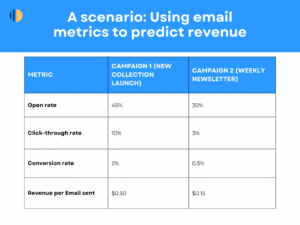Think about your last email marketing report. What was the first thing you looked at?
If you’re like most people, it was probably the open rate. It’s the number we all get excited about.
A high open rate feels good, like your subject line was a superstar. But let me ask you this: did that high open rate put money in the bank?
The truth is, while open rates are a good starting point, they are a vanity email marketing metric. They tell you that people are seeing your emails, but they don’t tell you if those emails are actually working. They don’t predict revenue.
If you’re serious about turning your email list into a revenue-generating machine, it’s time to look beyond the open rate.
I’m going to walk you through 5 essential email marketing metrics that truly matter; the ones that predict revenue, inform your strategy, and help you grow your business.
First, let’s talk about why open rate is not the best email marketing metric to predict revenue.
The Problem with Just Looking at Open Rates
Imagine you send an email to 10,000 people. Your open rate is a fantastic 50%. You might be high-fiving yourself.
But what if only 10 people clicked a link in that email? And what if only one person actually bought something? That amazing open rate suddenly doesn’t look so hot.
Open rates can be misleading for a few reasons:
- Email Client Limitations: Some email clients (especially older ones) don’t automatically load images. If an email has no tracking pixel (a tiny, invisible image used to track opens), it won’t be counted as “opened,” even if the person read every word.
- Privacy Updates: Apple’s Mail Privacy Protection (MPP) automatically pre-fetches and caches email content, which can artificially inflate open rates for users on their devices.
- Lack of Action: An open simply means the email was viewed. It doesn’t mean the person engaged with the content, clicked a link, or took any action that leads to revenue.
So, while an open is the first step, it’s not the one that moves the needle. Now, let’s get into the metrics that really count.
5 Email Marketing Metrics That Predict Revenue
To truly understand the performance of your email campaigns, you need to track metrics that are tied directly to user action and, ultimately, your bottom line.
- Click-Through Rate (CTR)
This is the next logical step after an open. The click-through rate tells you what percentage of people who opened your email actually clicked on a link inside it.
It’s a direct measure of how engaging your content is. A high CTR means your message resonated with your audience.
Formula for calculating CTR: (Number of Clicks/Number of Delivered Emails)∗100
Why it matters: CTR is the bridge between engagement and action. A strong CTR indicates that your call to action (CTA) is clear and compelling.
If you have a high open rate but a low CTR, it’s a sign that your email content or offer needs to be improved.
- Conversion Rate
This is the ultimate measure of email campaign success.
The conversion rate tells you what percentage of people who clicked a link in your email went on to complete a desired action.
This could be making a purchase, signing up for a webinar, or downloading an e-book.
Formula for calculating conversion rate: (Number of Conversions/Number of Delivered Emails)∗100
Why it matters: This email marketing metric connects your email campaign directly to a business outcome.
A high conversion rate shows that your email is not just driving traffic but also driving profitable actions.
What is a good conversion rate for email marketing?
A good conversion rate can vary widely depending on your industry and the goal of your email. However, studies often show that the average email marketing conversion rate is around 1-5%.
For most industries, a rate of 2-3% is considered solid. But don’t just chase averages. The most important thing is to improve your own rate over time.
- Revenue Per Email Sent (RPES)
This is my favorite email marketing metric. It’s simple, powerful, and directly connects your email campaigns to money.
Revenue per email sent tells you how much revenue, on average, each email in your campaign generates.
Formula for calculating RPES: (Total Revenue from Campaign/Number of Delivered Emails)
Why it matters: This email marketing metric gives you a clear picture of the financial value of each email you send.
It helps you understand which campaigns are the most profitable and which ones might need to be re-evaluated.
- Unsubscribe Rate
The unsubscribe rate is a key indicator of your email list’s health and the relevance of your content.
A high unsubscribe rate means your emails are not meeting your subscribers’ expectations.
Formula: (Number of Unsubscribes/Number of Delivered Emails)∗100
Why it matters: While some unsubscribes are normal, a sudden spike can signal a problem, such as:
- Sending too frequently
- Irrelevant or low-quality content
- Misleading subject lines
Pay attention to this metric to ensure you are providing value and not just spamming your audience.
- List Growth Rate
A healthy email list is a growing one. This email marketing metric shows how quickly your email list is expanding, which is vital for long-term business growth.
Formula: ((New Subscribers−Unsubscribes)/Total Subscribers)∗100
Why it matters: Your email list naturally loses subscribers over time due to inactivity or unsubscribes. A positive list growth rate ensures you are consistently reaching new potential customers.
How to Use These Email Marketing Metrics to Predict Revenue: A Practical Guide
Now, you have the numbers, what do you do with them? The magic happens when you analyze these metrics together to tell a story.
Let’s look at an example.
Scenario: You run an online store selling handcrafted jewelry.
Campaign Goal: Drive sales for a new collection.

Analysis:
Campaign 1 has a higher open rate, but the real story is in the CTR and Conversion Rate. A 10% CTR shows that your new collection was highly appealing, and a 2% conversion rate means that a good portion of those clickers made a purchase. The RPES of $0.50 clearly indicate this campaign was a financial success.
Campaign 2 has lower numbers across the board, which is expected for a less “promotional” email. However, you can see its value is still there. If you sent this to 10,000 people, it would still generate $1,500 in revenue.
By looking at these numbers together, you can see that Campaign 1 was a powerful revenue driver. You can use this data to create similar high-performing campaigns in the future.
Frequently Asked Questions (FAQs)
Q: Why is open rate not a good metric?
A: As mentioned earlier, open rate is an initial indicator, not a measure of success. It can be artificially inflated by privacy settings (like Apple’s Mail Privacy Protection) and doesn’t tell you if your subscribers actually engaged with the content, clicked a link, or made a purchase.
Q: What is a good email click-through rate?
A: A good email CTR can range from 2-5% on average, but this varies by industry and campaign type. E-commerce often sees higher rates, while B2B might be slightly lower. The key is to analyze your own historical data and aim for continuous improvement.
Q: How do you measure email campaign ROI?
A: To measure email campaign ROI (Return on Investment), you need to calculate the revenue generated from the campaign and subtract the total costs (e.g., email marketing software, content creation). The formula is:
ROI = (Total Revenue−Total Cost)/Total Cost
For example, if a campaign generates $5,000 in revenue and costs $500, the ROI is 9. That means for every $1 you spent, you got back $9.
Conclusion
If you’re still obsessing over open rates, I urge you to shift your focus. The numbers that truly matter are the ones that reflect action and revenue.
Start tracking your click-through rate, conversion rate, and revenue per email sent. These email marketing metrics are the real indicators of your email marketing success.
So, the next time you look at your report, don’t just celebrate the open rate. Dig deeper. Find the numbers that prove your email campaigns are not just being seen, but are actually growing your business.
Ready to start measuring what matters? Share your thoughts in the comments below! What email marketing metrics are you focusing on to predict and drive revenue? Let’s keep the conversation going.




